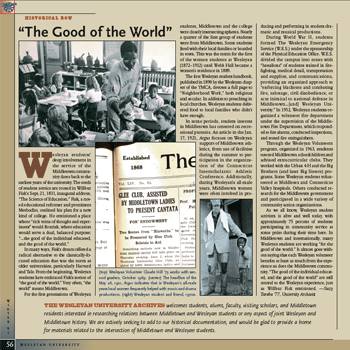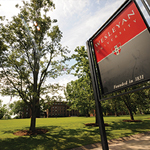HISTORICAL ROW: “THE GOOD OF THE WORLD”
 Wesleyan students’ deep involvement in the service of the Middletown community dates back to the earliest years of the university. The seeds of student service are rooted in Willbur Fisk’s Sept. 21, 1831, inaugural address, “The Science of Education.” Fisk, a noted educational reformer and prominent Methodist, outlined his plan for a new kind of college. He envisioned a place where “rich veins of thought and experiment” would flourish, where education would serve a dual, balanced purpose: “?the good of the individual educated, and the good of the world.”
Wesleyan students’ deep involvement in the service of the Middletown community dates back to the earliest years of the university. The seeds of student service are rooted in Willbur Fisk’s Sept. 21, 1831, inaugural address, “The Science of Education.” Fisk, a noted educational reformer and prominent Methodist, outlined his plan for a new kind of college. He envisioned a place where “rich veins of thought and experiment” would flourish, where education would serve a dual, balanced purpose: “?the good of the individual educated, and the good of the world.”
In many ways, Fisk’s dream offered a radical alternative to the classically–focused education that was the norm at older universities, particularly Harvard and Yale. From the beginning, Wesleyan students have embraced Fisk’s notion of “the good of the world.” Very often, “the world” meant Middletown.
For the first generations of Wesleyan students, Middletown and the college were closely intersecting spheres. Nearly a quarter of the first group of students were from Middletown. Some students lived with their local families or boarded in town. This was the norm for the first of the women students at Wesleyan (1872?1912) until Webb Hall became a women’s residence in 1889.
The first Wesleyan student handbook, published in 1890 by the Wesleyan chapter of the YMCA, devotes a full page to “Neighborhood Work,” both religious and secular. In addition to preaching in local churches, Wesleyan students delivered food to local families who didn’t have enough.
In some periods, student interest in Middletown has centered on recreational pursuits. An article in the Jan. 17, 1921, Argus focuses on Wesleyan support of Middletown athletics, from use of facilities during the summer to participation in the organization of the Connecticut Interscholastic Athletic Conference. Additionally, during Wesleyan’s all–male years, Middletown women were often involved in producing and performing in student dramatic and musical productions.
During World War II, students formed The Wesleyan Emergency Service (W.E.S.) under the sponsorship of the Physical Education Office. W.E.S. divided the campus into zones with “battalions” of students trained in firefighting, medical detail, transportation and supplies, and communications, providing an organized approach to “enforcing blackouts and combating fire, sabotage, civil disobedience, or acts inimical to national defense in Middletown?[and] Wesleyan University.” In 1952, Wesleyan students organized a volunteer fire department under the supervision of the Middletown Fire Department, which responded to fire alarms, conducted inspections, and tested fire extinguishers.
Through the Wesleyan Volunteers program, organized in 1963, students tutored Middletown schoolchildren and advised extracurricular clubs. They worked with the Urban 4–H and the Big Brothers (and later Big Sisters) programs. Some Wesleyan students volunteered at Middlesex and Connecticut Valley hospitals. Others conducted research for the Middletown government and participated in a wide variety of community action organizations.
As we all know, Wesleyan student activism is alive and well today, with approximately 75 percent of students participating in community service at some point during their time here. In Middletown and internationally, many Wesleyan students are working “for the good of the world.” It almost goes without saying that each Wesleyan volunteer benefits at least as much from the experience as does the Middletown community. “The good of the individual educated, and the good of the world” are still central to the Wesleyan experience, just as Willbur Fisk envisioned.
–Suzy Taraba ’77
University Archivist

